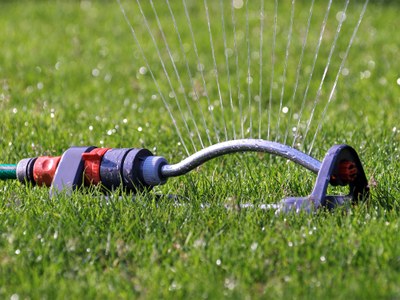Super Summer Lawns
Lawns in North Dakota hate the heat. The grass turns yellow and goes dormant as temperatures rise.
It’s okay to let your lawn go dormant—it’s natural. But if you don’t like looking at golden grass, let’s talk about summer lawn care:
Water deeply. It’s better to give your lawn a big gulp of water rather than a series of sips. That’s because roots grow where the water is. If you give the lawn a big gulp and water deeply, you will develop a deep root system. On the other hand, if you only sprinkle the surface of the soil, you will create a shallow root system.
Lawns need about 1.0 to 1.5 inches of water per week, either from you or rainfall. If you have a clay soil, irrigate only once or twice a week. Sandy soils can’t hold a full inch of water. These soils should receive about 0.5 inch of water two or three times per week when needed.
Watering in the early morning is best. The grass plants are active and will absorb the water they need. Any extra water will evaporate, keeping the grass blades dry and preventing diseases. Watering during the middle of the day is not recommended since much of the water you apply will evaporate before the plants absorb it. Watering is the early evening is not recommended since the lawn will stay wet all night, leading to diseases.
Mow your turf tall—the taller the better. A tall turf will shade the soil, keeping it cool. A taller turf naturally develops a deeper root system, protecting your lawn against drought damage. The first lawns in the neighborhood that turn yellow are lawns that are mowed short.
Your grass will be healthier and less thirsty if you let your grass clippings fall to the ground. These clippings will shade the soil surface, keeping it cool.
Avoid using weed killers on your lawn in the summer. You will have better success at killing weeds in September. Herbicides add extra stress to lawns, which are already under stress from the heat. There is also the risk of the herbicide drifting into your garden, causing these plants to curl and/or die.
Don’t be too worried about grubs or other insects. Less than 5% of our lawns need treatments for insect pests. Before treating, make sure you actually have a problem.
Grubs are the most common pest. Dig a couple inches deep along the edges of emerging brown spots. The grubs, which are creamy white in color and the size of your pinkie finger, will be munching on the grass roots. A few grubs are normal; treatments are not recommended until you find three or more grubs per square foot.
Don’t burn the lawn with fertilizer. Heat-stressed lawns do not need fertilizer, but a light fertilization might be necessary if you irrigate all summer. Use about one-half the suggested rate. Organic fertilizers are especially useful in summer since they are less likely to burn the grass.
Whether or not you actively take care of your lawn in summer, expect the lawn to wake up when temperatures cool off. Autumn is the best time to reseed, kill weeds, fertilize and aerate the lawn.
Written by Tom Kalb, Extension Horticulturist, North Dakota State University.






